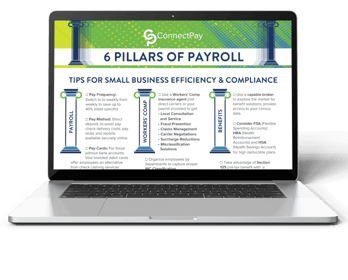
As a small business owner, the term "non-discrimination testing" might sound intimidating. However, it's a crucial process that makes sure your Section 125 cafeteria plan is fair and compliant with IRS rules.
But what kind of testing should you be doing? How often should you do it? And what are the real business benefits of taking the time to stay up-to-date in this area? The good news is that you don't have to navigate this complex testing alone.
In this blog post, we'll break down the essentials of non-discrimination testing for Section 125 plans. We'll also cover the three main test types, step-by-step instructions for completing them, and how the right payroll provider can streamline your entire process.
How to Perform Non Discrimination Testing for Section 125: First Things First
Whether you already have a Section 125 Cafeteria Plan (or another employee benefits plan) or you’re considering implementing one, you must make sure it treats all your employees fairly.
That's where non-discrimination testing comes in. It's like a checkup for your plan to ensure it's not giving preferential treatment to your higher-up or longer-employed team members.
The IRS requires non discrimination testing if you want to keep your plan's tax-advantaged status. Plus, promoting fairness and equity in your employee benefits shows you're committed to running your plan by the book and taking care of all your employees.
In addition to helping you stay compliant with IRS rules, avoid potential penalties, and keep your plan's tax benefits intact, non discrimination testing helps you as an employer. It encourages more employees to participate in the plan, leading to a healthier, happier workforce. And, if any issues with your plan's design or participation come up, you can address them before they get out of hand.
Now, you might be wondering how to run these tests and how often you need to do them. The short answer is every year–ahead of your plan renewal date–to stay on the IRS's good side.
You could try to tackle it yourself with a bunch of spreadsheets, or you can reference reports and accurate payroll data from your payroll provider to stay on track and accountable throughout the year.
How to Perform Non Discrimination Testing for Section 125: 3 Main Test Types (and steps to complete them)
To make sure that your Section 125 plan complies with IRS regulations and provides fair benefits to all employees, you'll conduct three main non-discrimination tests:
- Eligibility Test
- Contributions and Benefits Test
- Key Employee Concentration Test
These tests help prevent discrimination in favor of highly compensated employees (HCEs) or key employees, ensuring that your plan offers equitable benefits to all participants.
1. The Eligibility Test
The non discrimination Eligibility Test ensures that your Section 125 plan does not discriminate against certain employees when it comes to participation eligibility. It verifies that a sufficient percent of your company’s non-highly compensated employees (NHCEs) are eligible for the plan.
While HCEs can also participate in the plan, their ability to contribute and the types of benefits they can receive might be limited if your plan fails the eligibility non-discrimination test.
To complete the Eligibility Test, follow these steps:
- Determine the total number of employees eligible to participate in the plan.
- Calculate the percentage of HCEs who are eligible.
- Calculate the percentage of NHCEs who are eligible.
- Ensure that the percentage of eligible NHCEs is at least 50 percent of the percentage of eligible HCEs.
- If the test fails, consider modifying the eligibility criteria to include more NHCEs or limiting the eligibility of HCEs.
2. The Contributions and Benefits Test
The Contributions and Benefits Test takes a closer look at how your Section 125 plan treats HCEs and NHCEs when it comes to the actual contributions and benefits. This test ensures that the plan does not discriminate in favor of HCEs.
This test compares the average contributions and benefits of HCEs to those of NHCEs. If the average contributions and benefits for NHCEs are less than 75 percent of the average contributions and benefits for HCEs, your plan might unfairly discriminate towards your higher-up or long-term team members.
To complete the Contributions and Benefits Test, follow these steps:
- Determine the total number of employees participating in the plan.
- Calculate the average contributions and benefits for HCEs.
- Calculate the average contributions and benefits for NHCEs.
- Ensure that the average contributions and benefits for NHCEs are at least 75 percent of the average contributions and benefits for HCEs.
- If the test fails, adjust the contribution and benefit levels to ensure a more equitable distribution between HCEs and NHCEs.
3. The Key Employee Concentration Test
The Key Employee Concentration Test is designed to prevent key employees (officers, highly compensated employees, and owners) from receiving a disproportionate amount of nontaxable benefits compared to your other employees.
The Key Employee Concentration Test limits the nontaxable benefits provided to key employees to a maximum of 25 percent of the total nontaxable benefits provided to all employees. If your nontaxable benefits to key employees exceed this 25 percent threshold, your plan might be discriminatory, and you should revise it.
How do you complete the Key Employee Concentration Test? Follow these steps:
- Identify key employees (officers, highly compensated employees, and owners).
- Calculate the total nontaxable benefits provided to key employees.
- Calculate the total nontaxable benefits provided to all employees.
- Ensure that the nontaxable benefits provided to key employees do not exceed 25 percent of the total nontaxable benefits provided to all employees.
- If the test fails, adjust the distribution of nontaxable benefits or consider creating a separate plan for key employees to maintain compliance.
How to Perform Non Discrimination Testing for Section 125: Your Key To Compliance
You now understand the importance of conducting non-discrimination testing to maintain compliance with your Section 125 plan. However, navigating the intricacies of non-discrimination testing can be difficult, particularly for small businesses with limited resources.
This is where your payroll provider can step in to help you maintain compliance and streamline the testing process. Payroll providers simplify non-discrimination testing by offering essential payroll data for your employees and testing tools to perform tests accurately
The right payroll provider will also help you keep accurate records and stay informed about compliance changes.
Connect Section 125: Master Plan Document Compliance
At ConnectPay, we don't sell Section 125 plans or offer insurance plans, but our Connected Payroll model can help you find trusted, local insurance brokers to explore your Section 125 options. We do offer the documentation required to maintain compliance for your current Section 125 plan. Do you need a Section 125 Plan Document? We can help!
Our new service, Connect Section 125, is an affordable solution for small businesses to master Section 125 Plan Document compliance. Our user-friendly portal and tools allow you to manage your Section 125 compliance needs throughout the year easily. By utilizing Connect Section 125, you can access a suite of interactive testing tools and compliance resources to keep your plan document up-to-date all year round.
Curious about what ConnectPay can do for your business? Explore Connect Section 125 to see how we can help you maintain Section 125 Plan Document compliance and streamline your non-discrimination testing process.








